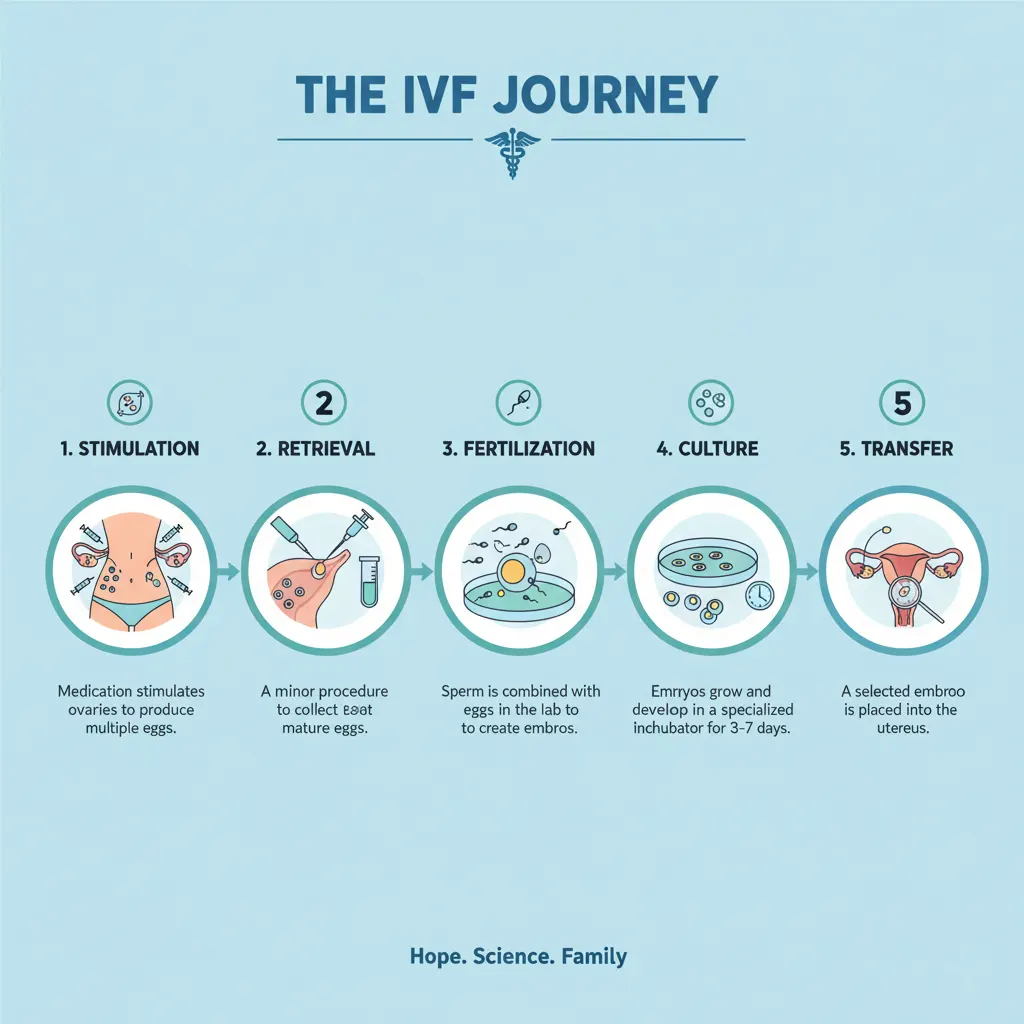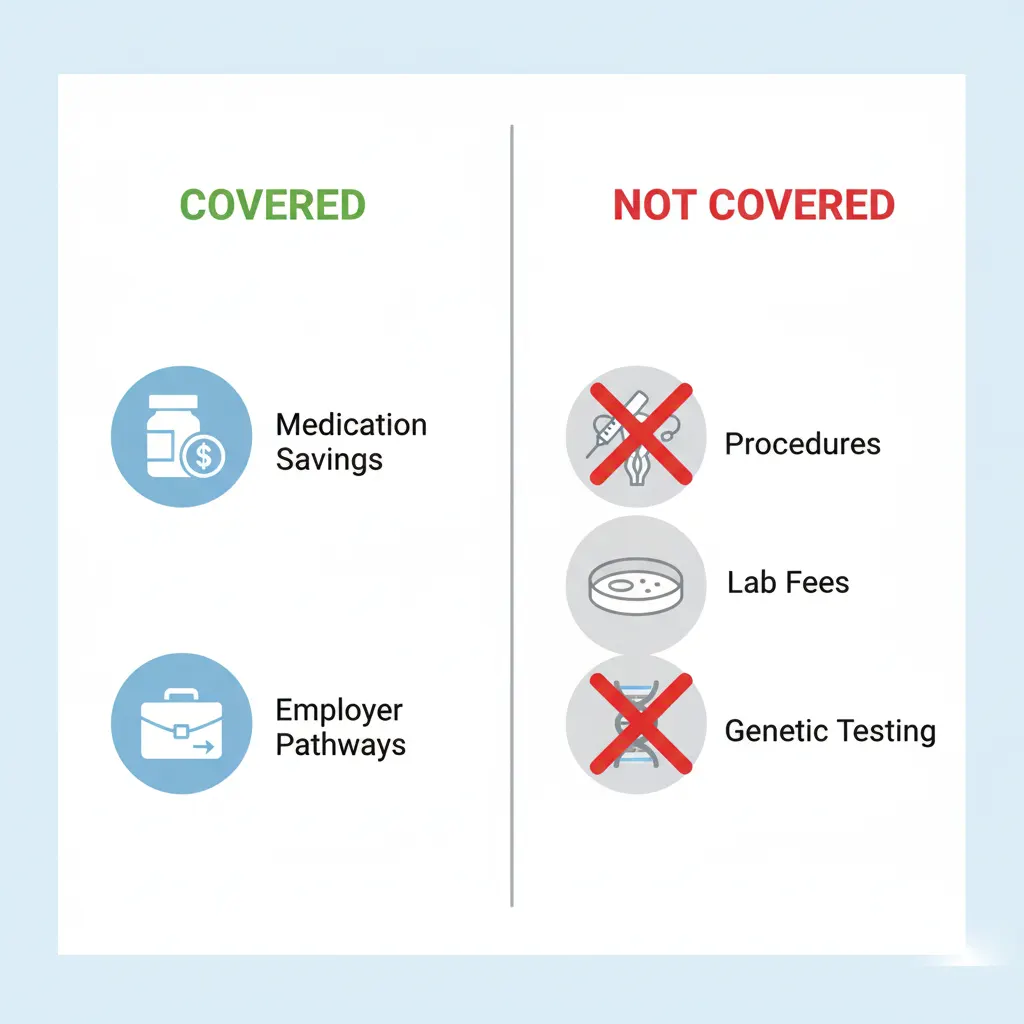Introduction: A Game-Changer for American Families Struggling With Infertility
President Donald Trump announced on October 16, 2025, a groundbreaking agreement to sell common fertility drugs at steeply reduced prices through TrumpRx, a new direct-to-consumer drug platform launching in January 2026. For millions of Americans facing infertility challenges, this plan represents the most significant federal intervention in IVF affordability in decades.
In vitro fertilization (IVF) costs average between $15,000 to $30,000 per cycle in the United States, with fertility medications alone adding $2,000 to $7,000 to each treatment cycle. According to the White House, costs per IVF cycle can range from $12,000 to $25,000, making this fertility treatment financially out of reach for countless hopeful parents.
This comprehensive guide breaks down everything American families need to know about Trump’s IVF drug pricing plan, including eligibility requirements, potential savings, state-by-state insurance coverage, and actionable steps you can take today.

What Is IVF and Why Does It Cost So Much?
Understanding In Vitro Fertilization (IVF)
In vitro fertilization is an assisted reproductive technology (ART) where eggs are surgically removed from the ovaries, fertilized with sperm in a laboratory setting, and then transferred back to the uterus. According to White House data, as many as one in seven American couples struggle with infertility, making IVF a critical option for family formation.
The IVF process involves several stages:
- Ovarian stimulation using injectable hormone medications
- Egg retrieval (oocyte retrieval) under anesthesia
- Fertilization in a laboratory environment
- Embryo culture and development
- Embryo transfer to the uterus

The True Cost of IVF Treatment in America
According to GoodRx, the average IVF cycle costs $12,400 in the U.S., not including medications and genetic testing for embryos. However, total expenses quickly escalate:
- Basic IVF cycle: $12,000 – $25,000
- Fertility medications: $2,000 – $7,000 per cycle
- Genetic testing (PGS): $3,000 – $5,000
- ICSI (Intracytoplasmic sperm injection): $1,000 – $2,500
- Embryo freezing and storage: $500 – $1,000+ annually
- Total per cycle: $20,000 – $30,000+
According to FertilityIQ data, the average patient undergoes 2.3 to 2.7 IVF cycles in total, meaning the average patient spends close to $50,000 in treatment.
For more detailed information on IVF costs, visit the American Society for Reproductive Medicine (ASRM) or RESOLVE: The National Infertility Association.
Trump’s IVF Drug Plan: Breaking Down the Details
The Historic Pharmaceutical Agreement
Under the plan announced October 16, 2025, costs to patients for three IVF drugs made by EMD Serono could be reduced by more than 70%. President Trump stated that the per-cycle cost of drugs used in IVF will fall by an estimated 73% for American consumers.
Which Fertility Medications Are Included?
The drugs, sold under the brand names Gonal-F, Ovidrel and Cetrotide, currently typically cost $5,000 per IVF cycle. These three injectable medications form the backbone of most IVF treatment protocols:
- Gonal-F (Follitropin alfa): Stimulates the ovaries to produce multiple eggs
- Ovidrel (Choriogonadotropin alfa): Triggers final egg maturation before retrieval
- Cetrotide (Cetrorelix): Prevents premature ovulation during the stimulation phase
How the TrumpRx Platform Works
As part of this agreement, EMD Serono will list their fertility drugs online at TrumpRx.gov at heavily reduced prices. This direct-to-consumer pharmaceutical platform bypasses traditional pharmacy markups and insurance complexities, allowing patients to purchase medications at negotiated government prices.
Launch Date: January 2026
Eligible Patients: All Americans seeking IVF treatment, with additional discounts for low- and middle-income families
Income-Based Additional Savings
Low- and middle-income women—defined as those with household incomes below 550% of the federal poverty level—will receive even deeper discounts beyond the standard 73% reduction. For a family of four in 2025, this means households earning up to approximately $150,000 annually could qualify for additional savings.
How Much Money Can Your Family Actually Save?
Standard Pricing Comparison
Current IVF Medication Costs (Per Cycle):
- Gonal-F, Ovidrel, Cetrotide: ~$5,000
After 73% Discount:
- Same medications: ~$1,350
- Savings per cycle: $3,650
For Multiple Cycles:
- 2 cycles: Save $7,300
- 3 cycles: Save $10,950
Additional Discounts for Low-Middle Income Families
Families earning below 550% of the federal poverty level may see total savings exceeding $2,200 per cycle when combining the standard discount with income-based reductions.
Real-World Impact
Dr. Kaylen Silverberg, a fertility specialist and advisory board chair for Americans for IVF, reported that some patients have spent upwards of $17,000 out of pocket on fertility drugs alone. When the president’s announcement was made, patients in his office were crying with happiness.
For comprehensive fertility treatment pricing by city, visit FertilityIQ’s Cost Analysis.
The Employer Coverage Initiative: What You Need to Know
New Regulatory Pathway for Fertility Benefits
President Trump previewed a plan to spur employers to offer more IVF coverage to their employees. The Department of Labor, Treasury Department and Department of Health and Human Services will issue guidance allowing fertility benefits to be offered as accepted benefits outside of major medical insurance plans.
Current Employer Coverage Statistics
According to a Mercer survey, nearly half of companies with 500 or more employees covered IVF in their broadest health care plans in 2024—more than double the number of similar-sized companies that covered IVF in 2019. However, smaller companies with fewer than 500 employees are far less likely to offer the benefit.
According to the 2024 Employee Benefits Survey by the International Foundation of Employee Benefit Plans, 42 percent of overall respondents offered fertility benefits, with 76 percent of group health plans covering IVF treatments.
Important Limitations
Taxpayers won’t be subsidizing fertility coverage, and while the Trump administration is encouraging employers to offer fertility coverage, there will be no requirement for employers to do so.
State-by-State IVF Insurance Coverage: Where Does Your State Stand?
States Requiring IVF Coverage (2025)
As of 2025, nearly half the states have enacted laws requiring at least some coverage for infertility services on state-regulated health plans. Twenty-two states and the District of Columbia currently have IVF coverage mandates on the books.
States with IVF Coverage Requirements:
- Arkansas – Limited coverage with restrictions
- California – New law effective July 2025 requires large group plans (100+ employees) to cover IVF, including maximum of three egg retrievals and unlimited embryo transfers
- Colorado – Large group plans must cover three completed oocyte retrievals and unlimited embryo transfers
- Connecticut – Comprehensive IVF coverage
- Delaware – Mandates IVF coverage
- Hawaii – Coverage with restrictions
- Illinois – Comprehensive fertility treatment coverage
- Louisiana – Limited coverage
- Maryland – First state to mandate IVF coverage (1985)
- Massachusetts – Comprehensive coverage
- Montana – Limited coverage
- New Hampshire – Mandates IVF coverage
- New Jersey – Comprehensive fertility treatment coverage
- New York – Large group health plans must cover up to three IVF cycles and prescription medications, with prohibition on discrimination based on age, sex, sexual orientation, marital status, or gender identity
- Ohio – Limited coverage
- Rhode Island – Mandates IVF coverage
- Texas – Insurers must offer coverage; employers decide whether to provide
- Utah – Coverage contingent on genetic conditions
- West Virginia – First infertility coverage mandate (1977)
- District of Columbia – New legislation approved for 2025
For the most current state-by-state breakdown, visit RESOLVE’s Insurance Coverage by State.
States Without IVF Mandates
The remaining 29 states do not require private insurance to cover any fertility services. Residents in these states rely entirely on employer-provided benefits or out-of-pocket payment.
Federal Coverage Options
The federal government covers IVF in a limited capacity for military personnel, veterans, and federal employees.
Comparing Trump’s Plan to His Campaign Promises
The Campaign Promise vs. Reality
During his campaign, Trump promised that “under the Trump administration, your government will pay for — or your insurance company will be mandated to pay for — all costs associated with IVF treatment”.
The current insurance announcement falls well short of this campaign promise to ensure universal free IVF coverage. The new plan:
- ✓ Reduces drug costs by 73%+
- ✓ Creates employer coverage pathway
- ✗ Does NOT mandate universal coverage
- ✗ Does NOT include government subsidies for full treatment
- ✗ Does NOT cover procedure costs (egg retrieval, embryo transfer, etc.)
What’s Still Missing
While slashing drug prices by more than half represents significant progress, the drugs are just one expensive component of IVF. The cost also includes ultrasounds, anesthesia and other fees.
The Political Context: Why IVF Became a Priority
The Alabama Embryo Ruling That Changed Everything
In February 2024, Alabama’s Supreme Court ruled that frozen embryos are considered children under state law, potentially exposing IVF clinics and patients to wrongful death liability. The court decision launched IVF into the political spotlight, sparking bipartisan outrage and prompting Trump to quickly distance himself from the ruling.
America’s Declining Birth Rates
The general U.S. fertility rate is at another historic low, with the rate dropping 3% in 2023 from 2022. From 2014-2020, the rate consistently decreased by 2% annually. Department of Health and Human Services data reports that more than 85,000 infants were born as a result of IVF in 2021.
Bipartisan Support for IVF
While many Republicans oppose abortion, IVF remains popular across both parties. A Pew Research Center poll from April 2024 found that seven in 10 Americans support IVF access.
The History of IVF in America
The first baby conceived through IVF was born in 1978 in England, but the first in the U.S. was in 1981 in Norfolk, Virginia, with the birth of Elizabeth Carr. By 1988, at least 169 in vitro centers were operating in 41 states.
Expert Reactions: What Fertility Specialists Are Saying
Emotional Impact on Patients and Providers
Dr. Kaylen Silverberg stated this is “the first administration in 20 years that’s even wanted to talk about this”. His emotional account of patients crying with relief captures the profound human impact of addressing IVF costs.
Concerns About Infrastructure
Critics have argued that layoffs at the Centers for Disease Control and Prevention in April 2025 eliminated a six-person team that tracks assisted fertility procedures and potential factors in successful pregnancies. As one expert noted: “If you mandate coverage or make IVF free tomorrow, you need an infrastructure and an ecosystem that actually can take care of all these patients. We need innovation, we need automation, we need risk management.”
Skepticism About Previous Drug Deals
Healthcare policy analysts have expressed reservations about previous Trump pharmaceutical agreements, questioning whether the arrangements substantially impact what most Americans pay for medicine. The confidential nature of the EMD Serono agreement details has fueled these concerns.
Actionable Steps for American Families Planning IVF
1. Calculate Your Potential Savings
Use this formula to estimate your medication savings:
Current fertility drug cost: $5,000/cycle After 73% discount: $1,350/cycle Your savings: $3,650/cycle
For multiple cycles:
- 2 cycles: $7,300 in savings
- 3 cycles: $10,950 in savings
2. Check Your Income Eligibility
Determine if your household falls below 550% of the federal poverty level for additional discounts:
- Family of 2: Income up to ~$100,000
- Family of 3: Income up to ~$125,000
- Family of 4: Income up to ~$150,000
3. Contact Your Employer’s HR Department
Ask if your company plans to add standalone fertility coverage under the new regulatory framework. Even if they haven’t announced plans, employee interest could influence decision-making.
4. Explore Your State’s Insurance Requirements
Visit RESOLVE’s state-by-state coverage guide to understand your legal rights to fertility coverage.
5. Plan Your Treatment Timing
The TrumpRx platform launches in January 2026. If you’re flexible with timing, waiting could save thousands. However, always consult your fertility specialist—age and medical factors may outweigh financial considerations.
6. Research IVF Clinics and Costs
Compare pricing across multiple fertility clinics:
- FertilityIQ – Comprehensive cost comparisons by city
- SART (Society for Assisted Reproductive Technology) – Success rates and clinic data
- CNY Fertility – Affordable IVF options
7. Consider IVF Grants and Financial Assistance
Explore fertility treatment grants:
- CNY Fertility Grant (monthly)
- Baby Quest Foundation
- Cade Foundation
- The Tinina Q. Cade Foundation
8. Understand Tax Advantages
IVF expenses may be tax-deductible as medical expenses. Consult with a tax professional about:
- Health Savings Accounts (HSAs)
- Flexible Spending Accounts (FSAs)
- Medical expense deductions
What This Plan Does NOT Include

Critical Limitations to Understand
Does NOT cover:
- ✗ Egg retrieval procedures and anesthesia
- ✗ Embryo transfer procedures
- ✗ Laboratory fees and embryo culture
- ✗ Genetic testing (PGS/PGT)
- ✗ ICSI (intracytoplasmic sperm injection)
- ✗ Embryo freezing and storage fees
- ✗ Ultrasound monitoring
- ✗ Blood work and diagnostic testing
Does NOT provide:
- ✗ Universal coverage mandate
- ✗ Government subsidies for full treatment
- ✗ Requirement for employers to offer coverage
- ✗ Medicaid coverage expansion
IVF cycles can cost $25,000 or even more, and many couples need multiple cycles. Most employers don’t offer fertility insurance coverage.
Future Developments: What’s Coming Next?
Potential Expansions
New medications: EMD Serono is seeking expedited FDA review for Pergoveris, a combination therapy that could bring additional treatment options and competitive pricing pressure.
Additional pharmaceutical partnerships: Trump’s success negotiating with three major drug manufacturers may encourage other companies to seek similar deals.
State Medicaid expansion: The guarantee of most-favored-nation pricing for all state Medicaid programs could prompt coverage expansions.
Further regulatory guidance: The Treasury, Labor, and HHS departments plan to issue additional guidance to expand fertility benefit options.
Pending Federal Legislation
Federal lawmakers have introduced the “Health Coverage for IVF Act of 2025” that would require health plans to cover infertility treatment, though the bill’s future remains uncertain.
Frequently Asked Questions (FAQs) About Trump’s IVF Plan
Q: When does the TrumpRx platform launch?
A: January 2026
Q: Will I need a prescription to purchase medications from TrumpRx.gov?
A: Yes, fertility medications require a valid prescription from a licensed physician.
Q: Does this plan cover all IVF medications?
A: No, only three specific EMD Serono medications: Gonal-F, Ovidrel, and Cetrotide.
Q: Will my insurance cover the discounted medications?
A: TrumpRx is a direct-to-consumer platform designed to bypass insurance. You purchase medications directly at reduced prices.
Q: Can same-sex couples and single parents access these discounts?
A: Yes, the program is available to all Americans seeking IVF treatment regardless of marital status or sexual orientation.
Q: What if I live in a state without IVF insurance mandates?
A: The medication discounts through TrumpRx are available to all Americans regardless of state residence.
Q: Will Medicare or Medicaid cover IVF?
A: Currently, the federal government covers IVF in a limited capacity for military personnel, veterans, and federal employees. Medicaid coverage remains minimal in most states.
Resources for American Families Considering IVF
National Organizations
- RESOLVE: The National Infertility Association – Advocacy, support, and education
- American Society for Reproductive Medicine (ASRM) – Medical guidelines and research
- Society for Assisted Reproductive Technology (SART) – Clinic success rates and data
Financial Resources
- FertilityIQ – Cost analysis and clinic reviews
- CNY Fertility – Affordable IVF options
- GoodRx Fertility Guide – Medication pricing and savings
Government Resources
- White House Fact Sheet on IVF
- CDC Fertility Statistics
- TrumpRx.gov (launching January 2026)
State Insurance Information
- KFF State Health Facts – State-by-state coverage data
- National Conference of State Legislatures – Legislative tracking
Real Savings, Real Limitations
For the estimated 1 in 7 American couples facing infertility, Trump’s IVF drug plan represents meaningful, tangible relief. With the average patient spending close to $50,000 on IVF treatment, saving $3,650+ per cycle on medications is significant—potentially totaling $10,950+ in savings over three cycles.
Who Benefits Most?
Biggest winners:
- Families paying out-of-pocket for IVF
- Low- and middle-income families earning under $150,000 (family of four)
- Residents in states without insurance mandates
- LGBTQ+ couples and single parents without coverage
Still facing challenges:
- Families needing extensive procedures beyond medication
- Those in states without employer coverage requirements
- Patients requiring donor eggs, surrogacy, or complex treatments
The Path Forward
What the plan accomplishes is breaking ground on a politically fraught issue that has languished without federal action for decades. Whether viewed as a down payment on broader reform or a missed opportunity for universal coverage depends on one’s political perspective and personal circumstances.
For families desperate to become parents, the calculation is simpler: thousands of dollars in savings translates to hope, possibility, and the chance to build the families they’ve always dreamed of.
The conversation about IVF affordability and access is far from over—and American families’ voices will be critical in shaping future policy.
Key Takeaways
73% medication discounts on three critical IVF drugs starting January 2026 ✓
$3,650+ savings per cycle on fertility medications ✓
TrumpRx.gov platform launches for direct-to-consumer purchases ✓
Additional discounts for families earning under 550% federal poverty level ✓
New employer pathway for standalone fertility benefits (no mandate) ✓
22 states + D.C. currently have some IVF coverage requirements ✓
Does NOT include universal coverage mandate or government subsidies ✗
Does NOT cover procedure costs like egg retrieval or embryo transfer ✗
#IVF #Fertility #TrumpIVFPlan #IVFCost #FertilityTreatment #IVFJourney #Infertility #TTC (Trying To Conceive) #IVFSavings #AffordableIVF


